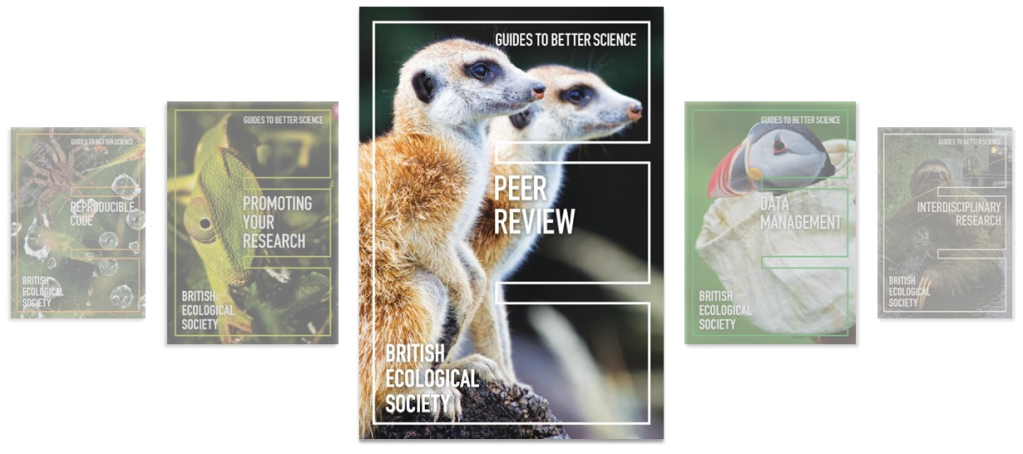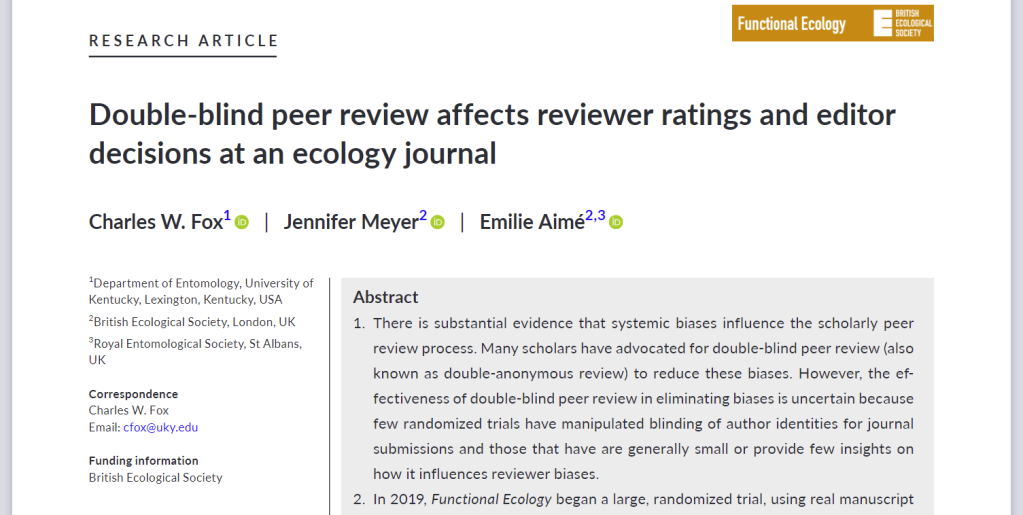
An introduction to peer review
Peer review is the evaluation of a scientific article by other scientists who are experts in the field. The feedback is generally used to improve the article, and to help the editors of a journal decide whether it merits publication. The integrity of the scientific literature rests on a peer review system that is robust, independent and fair. Although it’s not a perfect system – it has proven to provide real benefits to both authors and the reviewers themselves.
The manuscript workflow explained
Manuscripts submitted to the 7 BES journals are assessed by a Senior Editor, an Associate Editor, and if suitable, sent out to external peer reviewers. Manuscripts are also checked by our in-house editorial team who make sure all necessary information has been included for review. Take a look at the flowchart below which shows a typical manuscript journey:

Ensuring editorial best practices and peer review integrity
The BES strives to publish the highest quality research across our journals, through rigorous peer review and robust editorial policies. Here are some of the ways we work to ensure this:
✔️ Senior Editors: Each journal has a team of Senior Editors who are leading ecologists within their fields. Senior Editors are responsible for evaluating submissions and making the final decisions on publication, in addition to providing guidance for the board of Associate Editors. They also input to strategic plans to enhance the journal profiles and better serve our community of authors and readers.
✔️ Board of Associate Editors: Each journal has a Board of Associate Editors, who are recruited for their relevant knowledge and expertise. Associate Editors are responsible for selecting and inviting appropriate reviewers for each manuscript, assessing the reviewer comments, and making recommendations on manuscripts based on the reviewer feedback and their own professional opinion.
✔️ Peer reviewers: Ideally at least 2 independent reviewers are secured for every manuscript, who are asked to assess the assess the research quality, methodology and conclusions through a close reading of the paper.
✔️ Peer Review best practices: We take measures to ensure we represent the gold standard of peer review and limit misconduct. E.g. peer review manipulation can be mitigated by checking author-recommended reviewer email addressees and profiles for legitimacy, and securing independent reviewers as well as those suggested by authors.
✔️ In-house editorial team: The BES has an in-house editorial team including a Director of Publishing, a
Head of Product Development, Managing Editors, Assistant Editors and Publishing Assistants. Each journal has a dedicated person who checks that every manuscript complies with our editorial policies and best practices.
✔️ BES Publications Committee and Chairperson: The BES is led by a board of trustees and committees, made-up of people from the ecological community. We have a dedicated Publications Committee and Chairperson, who meet regularly to manage the strategic development of the journals.
✔️ Editorial policies: Our policies are regularly reviewed, and are set out in full on our website. Submissions should include any necessary permits regarding research ethics (e.g. animal ethics, human studies, field studies). All manuscripts should include a ‘Data Availability’ statement, a ‘Conflict of Interest’ statement, and an ‘Author Contributions’ statement. A ‘Statement of Inclusion’ should also be provided on submission, aiming to support more global representation in ecology. We do not consider manuscripts simultaneously submitted or published in another journal, in whole or in part – the BES uses CrossCheck to screen submitted manuscripts, to identify overlaps with previously published works.
✔️ COPE membership: The BES is a member of the Committee on Publication Ethics, which provides best practice guidelines and guidance on publishing ethics. In the event of research or publication misconduct, we follow COPE guidance in the first instance.
✔️ DORA: We are also signatories of DORA, whose mission is to advance practical and robust approaches to research assessment globally.
✔️ Wiley: The BES journals are published with Wiley – a global industry leader. We have a dedicated Publisher and production team at Wiley, and any issues can be escalated to Wiley’s ethics and legal teams. Wiley is a signatory of the SDG Publishers Compact, who set steps to accelerate progress to achieve the UN Sustainable Development Goals by 2030.
The evolution of peer review at the BES
Over recent years, peer review at the BES journals has evolved and we’ve employed the following initiatives, with the goal of increasing transparency and decreasing bias within the review process:

Double-anonymous peer review trial: In 2023 Functional Ecology published the results of a 3-year study on the effects of single- vs double-anonymous peer review. The results suggest that a double-anonymous system reduces reviewer bias towards authors. When reviewers did not know whose paper they were reviewing, peer review outcomes were similar across author demographics (interestingly, this was true even when reviewers correctly guessed the identity of the authors!). In contrast, when reviewers were told whose paper they were reviewing, papers with first authors residing in higher-income countries and in countries with higher English proficiency were favored. It’s critical for science, and for the scientists involved, that peer review is a fair and unbiased process. Based on the results of this trial, Functional Ecology has now transitioned to mandatory double-anonymous peer review, along with Methods in Ecology and Evolution, Journal of Applied Ecology, and Journal of Animal Ecology, and Journal of Ecology will follow very soon.

Collaborative peer review: Did you know that all BES journals encourage senior academics to review manuscripts in collaboration with more junior members of their labs? We believe this is a fantastic training opportunity for early career researchers.
“Co-reviewing provides an excellent mentoring opportunity, and a great way for early career researchers to familiarise themselves with the reviewing process. It also gives a different perspective when submitting their own work to be reviewed” – Joshua Hall (Tennessee Tech University)

Transparent peer review: Journal of Ecology, Methods in Ecology and Evolution, People and Nature, and Ecological Solutions and Evidence use a Transparent Peer Review process. If an article is accepted, the reviewer reports, authors’ responses, and the editor’s decision are all published on Publons, and the published article will include a direct link to these details. Authors have the opportunity to opt out during the submission process, and reviewers can decide whether or not their names appears on their report. We believe that increased transparency in peer review has many benefits – it helps make the peer review process more accountable, creates opportunities for peer review training, and allows reviewers to claim recognition for their reviews.
Reviewer Discussion: As reviewers often have very different expertise, the review process at People and Nature, and Ecological Solutions and Evidence includes a 5-day discussion period after all reviews have been submitted in which all reviewers are given the opportunity to comment on each other’s reports. The comments are then incorporated into the decision by the Editors. This feature helps ensure we draw out disciplinary differences in reviews and helps editors to ensure that any requested revisions to manuscripts are appropriate.

Transfer of reviews with rejections: If a manuscript is rejected after peer review, the BES Editors have the option to offer the authors a transfer to one of the other BES Journals or Ecology and Evolution (an open access journal that the BES partners with Wiley on). If the authors accept the offer, their manuscript will be transferred along with the reviewer comments and decision letter. This initiative aims to avoid the duplication of work and decrease the workload on reviewer pools.

Standardising Peer Review Terminology: People and Nature participated in a pilot of the NISO Working Group on Peer Review Terminology. Standardising terminology across journals and publishers used to describe peer review practices helps make the peer review process more transparent, and enables the community to better assess and compare peer review practices between different journals. The results of the pilot can be found here.
A Guide to Peer Review
For a full overview of the peer review process and more information on ethics and FAQs, take a look at the BES’s free Guide to Peer Review! (part of the Guides to Better Science series):

This blog post was published to celebrate Peer Review Week 2023 – an annual event which highlights the vital role of peer review in shaping scholarly communication.



